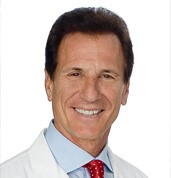Regenerative Medicine and Hair Regeneration: Androgenic Alopecia (AGA), Alopecia Areata (AA)
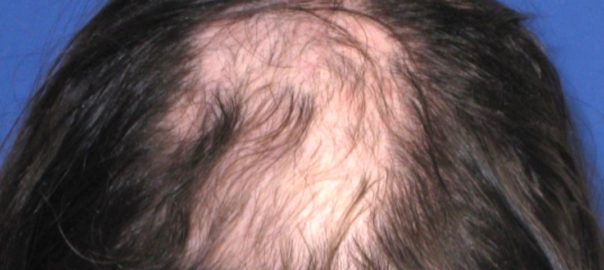
The prevalence of progressive AGA approaches 50% of Caucasian men and women beyond the age of 40; whereas in Asian, Native American, and African American men the prevalence is lower and less severe.
There is a definite pattern the author has seen the past 34 years in hair restoration. Ten years ago, seven of ten patients were males seeking hair transplantation. Today, seven of ten patients are females searching for some form of non-surgical hair improvement, while forty percent of surgery patients are also females. The trend is that more patients are females and the majority of patients are seeking some form of non-surgical hair improvement for AGA.
Traditional therapy in pre-menopausal females consists of Rogaine, Spironolactone and LED phototherapy while male treatments focus on DHT blockers like Finasteride, Dutesteride, LED therapy and Rogaine. However, the side effect profiles of medicines have many patients researching biologic therapy as a safe adjunctive treatment in combination or in lieu of traditional therapies.
Growth factors are present in the bulge area, where stem cells are found, and they interact with cells of the matrix, thus activating the proliferative phase of the hair. Stem cells are more primitive and of ectodermal origin; they give origin to the epidermal cells and the sebaceous glands. Cells of the dermal papilla, which are found at the capillary base, are of mesenchymal origin. Both cells need each other, and when they interact through the action of various growth factors, they will give rise to the future follicular unit.
Numerous studies the past ten years have led to more understanding how the various growth factors in Platelet Rich Plasma (PRP) work to improve hair regeneration. Vascular Endothelial Growth Factor (VEFG) promotes angiogenesis increasing the size of the hair shaft. Epidermal Growth Factor (EGF) improves the ratio of anagen phase (growth phase); Platelet Derived Growth Factor (PDGF) stimulates the growth of the dermal papilla.
Miao et al demonstrated “a considerable effect of PRP on the time of hair formation and yield of hair reconstitution” with higher concentrations of six times baseline platelet concentration compared to control and lesser concentrations. When used in hair transplant surgery autologous growth factors enhance the procedure by (1) healing faster thus reducing hypertrophic scaring in the donor area, (2) growth factors increase the yield of transplants follicles when bathed in autologous solutions and they (3) promote the growth of hair sooner and denser.
When used non-surgically, growth factors work to reduce scalp inflammation, promote angiogenesis increasing the density of hair, promote follicular transition into the anagen phase and help normalize shedding of hair. The author has had numerous patients whose hair is getting darker as the growth factors are turning on melanocytes and regenerating hair back to its natural color. The patient below Fig1, Fig 2 has been treated yearly since 2011 and has never colored her hair.
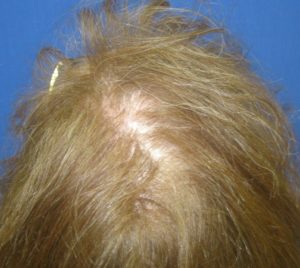
Figure 1 Before
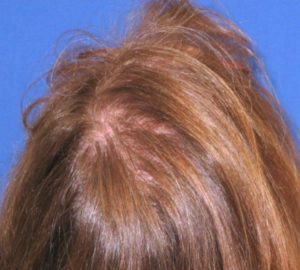
Figure 2 After
One of the most appealing factors in biologic treatments for physicians and patients is that “using ones own cells is safe”. In ten years of utilizing biologic therapy for hair the author has not had one adverse side effect. Additionally, Regenerative protocols can also be used in combination with traditional medicines as treatments to maintain and improve existing hair or used surgically to enhance the results of permanent hair restoration. There is not a treatment or therapy that is safer and as versatile in hair improvement than the use of autologous cellular therapy.
Autologous therapies can also be used to regenerate hair in autoimmune hair loss diseases like Alopecia Areata (AA) because of its powerful anti-inflammatory properties. Below is a female patient who failed traditional therapy including steroid injections. These are her results after three sessions of autologous growth factors.
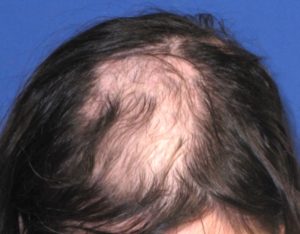
Figure 3 Before
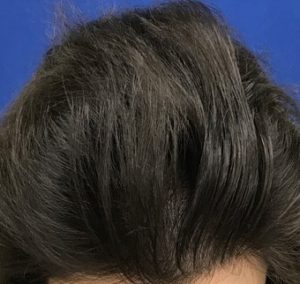
Figure 4 After
The future in hair regeneration is hair multiplication and the use growth factors and stem cells will be an integral part of that process. The best is yet to come!


